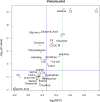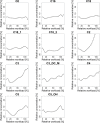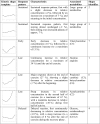Modeling and Classification of Kinetic Patterns of Dynamic Metabolic Biomarkers in Physical Activity
- PMID: 26317529
- PMCID: PMC4552566
- DOI: 10.1371/journal.pcbi.1004454
Modeling and Classification of Kinetic Patterns of Dynamic Metabolic Biomarkers in Physical Activity
Abstract
The objectives of this work were the classification of dynamic metabolic biomarker candidates and the modeling and characterization of kinetic regulatory mechanisms in human metabolism with response to external perturbations by physical activity. Longitudinal metabolic concentration data of 47 individuals from 4 different groups were examined, obtained from a cycle ergometry cohort study. In total, 110 metabolites (within the classes of acylcarnitines, amino acids, and sugars) were measured through a targeted metabolomics approach, combining tandem mass spectrometry (MS/MS) with the concept of stable isotope dilution (SID) for metabolite quantitation. Biomarker candidates were selected by combined analysis of maximum fold changes (MFCs) in concentrations and P-values resulting from statistical hypothesis testing. Characteristic kinetic signatures were identified through a mathematical modeling approach utilizing polynomial fitting. Modeled kinetic signatures were analyzed for groups with similar behavior by applying hierarchical cluster analysis. Kinetic shape templates were characterized, defining different forms of basic kinetic response patterns, such as sustained, early, late, and other forms, that can be used for metabolite classification. Acetylcarnitine (C2), showing a late response pattern and having the highest values in MFC and statistical significance, was classified as late marker and ranked as strong predictor (MFC = 1.97, P < 0.001). In the class of amino acids, highest values were shown for alanine (MFC = 1.42, P < 0.001), classified as late marker and strong predictor. Glucose yields a delayed response pattern, similar to a hockey stick function, being classified as delayed marker and ranked as moderate predictor (MFC = 1.32, P < 0.001). These findings coincide with existing knowledge on central metabolic pathways affected in exercise physiology, such as β-oxidation of fatty acids, glycolysis, and glycogenolysis. The presented modeling approach demonstrates high potential for dynamic biomarker identification and the investigation of kinetic mechanisms in disease or pharmacodynamics studies using MS data from longitudinal cohort studies.
Conflict of interest statement
KMW holds stock in sAnalytiCo Ltd. and in Biocrates Life Sciences AG. CB, MB, MN declare no competing interests.
Figures








Similar articles
-
The combination of four analytical methods to explore skeletal muscle metabolomics: Better coverage of metabolic pathways or a marketing argument?J Pharm Biomed Anal. 2018 Jan 30;148:273-279. doi: 10.1016/j.jpba.2017.10.013. Epub 2017 Oct 18. J Pharm Biomed Anal. 2018. PMID: 29059617
-
Unveiling metabolic remodeling in mucopolysaccharidosis type III through integrative metabolomics and pathway analysis.J Transl Med. 2018 Sep 4;16(1):248. doi: 10.1186/s12967-018-1625-1. J Transl Med. 2018. PMID: 30180851 Free PMC article.
-
Automated pathway and reaction prediction facilitates in silico identification of unknown metabolites in human cohort studies.J Chromatogr B Analyt Technol Biomed Life Sci. 2017 Dec 15;1071:58-67. doi: 10.1016/j.jchromb.2017.04.002. Epub 2017 Apr 4. J Chromatogr B Analyt Technol Biomed Life Sci. 2017. PMID: 28479069
-
High resolution mass spectrometry based techniques at the crossroads of metabolic pathways.Mass Spectrom Rev. 2014 Nov-Dec;33(6):471-500. doi: 10.1002/mas.21401. Epub 2013 Nov 28. Mass Spectrom Rev. 2014. PMID: 24288070 Review.
-
Mass spectrometry-based metabolomics: applications to biomarker and metabolic pathway research.Biomed Chromatogr. 2016 Jan;30(1):7-12. doi: 10.1002/bmc.3453. Epub 2015 Mar 4. Biomed Chromatogr. 2016. PMID: 25739660 Review.
Cited by
-
An NMR-Based Approach to Identify Urinary Metabolites Associated with Acute Physical Exercise and Cardiorespiratory Fitness in Healthy Humans-Results of the KarMeN Study.Metabolites. 2020 May 21;10(5):212. doi: 10.3390/metabo10050212. Metabolites. 2020. PMID: 32455749 Free PMC article.
-
Traumatic Brain Injury Biomarkers, Simulations and Kinetics.Bioengineering (Basel). 2022 Oct 25;9(11):612. doi: 10.3390/bioengineering9110612. Bioengineering (Basel). 2022. PMID: 36354523 Free PMC article.
-
Characterization of the Rotating Exercise Quantification System (REQS), a novel Drosophila exercise quantification apparatus.PLoS One. 2017 Oct 10;12(10):e0185090. doi: 10.1371/journal.pone.0185090. eCollection 2017. PLoS One. 2017. PMID: 29016615 Free PMC article.
-
Metabolome trajectories in male and female athletes.J Sport Health Sci. 2025 Jun 11;14:101065. doi: 10.1016/j.jshs.2025.101065. Online ahead of print. J Sport Health Sci. 2025. PMID: 40513715 Free PMC article.
-
Physiological extremes of the human blood metabolome: A metabolomics analysis of highly glycolytic, oxidative, and anabolic athletes.Physiol Rep. 2021 Jun;9(12):e14885. doi: 10.14814/phy2.14885. Physiol Rep. 2021. PMID: 34152092 Free PMC article.
References
-
- Guldberg CM, Waage P. Studier i affiniteten. (Translation: Studies on affinities.) Forhandlinger i Videnskabs-Selskabet i Christiania; 1864.
-
- Guldberg CM, Waage P. E´tudes sur les affinites chimiques. (Translation: Studies on chemical affinities.) Christiania: Brøgger & Christie; 1867.
-
- Guldberg CM, Waage P. Über die chemische Affinität. (Translation: On chemical affinity.) Erdmann’s Journal für practische Cehmie. 1879;127:69–114.
-
- Michaelis L, Menten ML. Die Kinetik der Invertinwirkung. (Translation: The kinetics of invertase activity.) Biochemische Zeitschrift. 1913;49:333–369.
MeSH terms
Substances
LinkOut - more resources
Full Text Sources
Other Literature Sources
Miscellaneous

